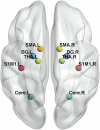An fMRI study on the generalization of motor learning after brain actuated supernumerary robot training
- PMID: 39738213
- PMCID: PMC11685389
- DOI: 10.1038/s41539-024-00294-y
An fMRI study on the generalization of motor learning after brain actuated supernumerary robot training
Abstract
Generalization is central to motor learning. However, few studies are on the learning generalization of BCI-actuated supernumerary robotic finger (BCI-SRF) for human-machine interaction training, and no studies have explored its longitudinal neuroplasticity mechanisms. Here, 20 healthy right-handed participants were recruited and randomly assigned to BCI-SRF group or inborn finger group (Finger) for 4-week training and measured by novel SRF-finger opposition sequences and multimodal MRI. After training, the BCI-SRF group showed 350% times compared to the Finger group in the improvement of sequence opposition accuracy before and after training, and accompanied by significant functional connectivity increases in the sensorimotor region and prefrontal cortex, as well as in the intra- and inter-hemisphere of the sensorimotor network. Moreover, Granger Causality Analysis identified causal effect main transfer within the sensorimotor cortex-cerebellar-thalamus loop and frontal-parietal loop. The findings suggest that BCI-SRF training enhances motor sequence learning ability by influencing the functional reorganization of sensorimotor network.
© 2024. The Author(s).
Conflict of interest statement
Competing interests: The authors declare no competing interests.
Figures






Similar articles
-
Enhanced Brain Functional Interaction Following BCI-Guided Supernumerary Robotic Finger Training Based on Sixth-Finger Motor Imagery.IEEE Trans Neural Syst Rehabil Eng. 2025;33:1519-1528. doi: 10.1109/TNSRE.2025.3562700. Epub 2025 Apr 29. IEEE Trans Neural Syst Rehabil Eng. 2025. PMID: 40257872
-
Enhancement of Functional Connectivity in Frontal-Parietal Regions After BCI-Actuated Supernumerary Robotic Finger Training.Annu Int Conf IEEE Eng Med Biol Soc. 2024 Jul;2024:1-4. doi: 10.1109/EMBC53108.2024.10781807. Annu Int Conf IEEE Eng Med Biol Soc. 2024. PMID: 40040056
-
Functional Reorganization After Four-Week Brain-Computer Interface-Controlled Supernumerary Robotic Finger Training: A Pilot Study of Longitudinal Resting-State fMRI.Front Neurosci. 2022 Feb 11;15:766648. doi: 10.3389/fnins.2021.766648. eCollection 2021. Front Neurosci. 2022. PMID: 35221886 Free PMC article.
-
Motor learning in man: a review of functional and clinical studies.J Physiol Paris. 2006 Jun;99(4-6):414-24. doi: 10.1016/j.jphysparis.2006.03.007. Epub 2006 May 26. J Physiol Paris. 2006. PMID: 16730432 Review.
-
Robotic treatment of the upper limb in chronic stroke and cerebral neuroplasticity: a systematic review.J Biol Regul Homeost Agents. 2020 Sep-Oct;34(5 Suppl. 3):11-44. Technology in Medicine. J Biol Regul Homeost Agents. 2020. PMID: 33386032
References
Grants and funding
- 62273251/National Natural Science Foundation of China (National Science Foundation of China)
- 81925020/National Natural Science Foundation of China (National Science Foundation of China)
- 21JCYBJC00520/Natural Science Foundation of Tianjin City (Natural Science Foundation of Tianjin)
- MSV202418/State Key Laboratory of Mechanical System and Vibration
LinkOut - more resources
Full Text Sources
Miscellaneous

